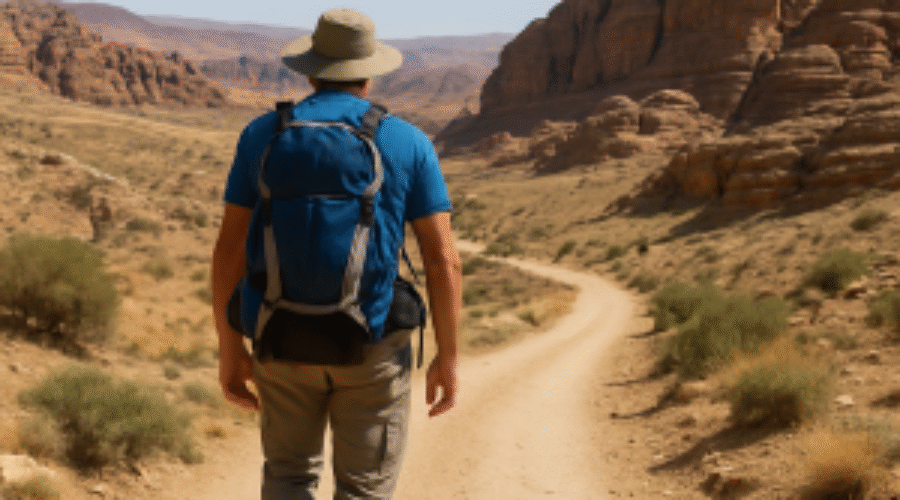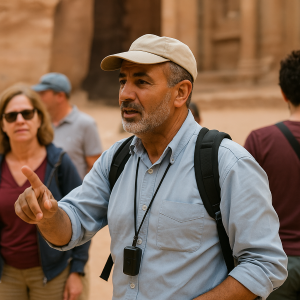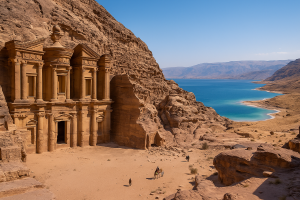Complete Guide to Jordan Trail: Costs, Pass and Hiking Tips
Walking the Jordan Trail: An Unforgettable Journey Across Jordan
There’s something magical about experiencing a country at walking pace. Cars and buses might get you there faster, but on foot you notice the scent of wild herbs, the sound of distant bells from goat herds, and the hospitality of people you meet along the way. Jordan is one of the best places in the world to do this, thanks to the Jordan Trail—a hiking route that spans the entire country from north to south.
In this article, I’ll take you through what the Jordan Trail is, why it’s gaining global attention, how the Jordan Trail Pass works, and why traveling Jordan by foot may end up being one of the most meaningful trips you’ll ever take.
What Is the Jordan Trail?
The Jordan Trail is a long-distance hiking route stretching over 650 kilometers (around 400 miles). It begins in Umm Qais in the far north, near the borders with Syria and Israel, and finishes in Aqaba, where the desert meets the Red Sea.
Along the way, the trail passes through 75 villages and towns, connecting historic sites, breathtaking valleys, biblical landmarks, and desert landscapes. It’s divided into eight main regions, each with unique scenery:
- Northern forests and hills around Ajloun and Umm Qais
- Roman ruins and fertile farmlands near Jerash
- Biblical sites in Madaba and Mount Nebo
- The Dead Sea area and Wadi Mujib canyons
- Dana Biosphere Reserve with its dramatic cliffs
- Petra, the rose-red city carved into stone
- Wadi Rum desert, with its Martian-like scenery
- Aqaba and the Red Sea, the final resting point
Walking this hiking trail in Jordan isn’t just about exercise—it’s about connecting all the threads of Jordan’s history, culture, and hospitality in one continuous journey.
Why Hike the Jordan Trail?
You might be asking: Why would anyone walk 650 kilometers when buses or tours can cover the same ground in a fraction of the time?
Here are some reasons that stand out:
1. Authentic Encounters
When you’re traveling Jordan by foot, you pass through villages most tourists never see. Locals invite hikers in for tea or a meal. I still remember sitting with a family in Ajloun who insisted I try their homemade olive oil with fresh bread. That wasn’t in any guidebook.
2. Physical Challenge and Reward
The trail takes around 40 days to complete if walked in one stretch, though many do it in sections. The physical challenge is real—especially in desert stretches—but the reward is huge. Reaching Petra on foot after days of walking feels like discovering the city as ancient traders once did.
3. Immersion in Nature
From oak forests in the north to the open skies of Wadi Rum, Jordan’s natural diversity is striking. Each region feels like a different world. Hikers often say the best part of the trail is the changing rhythm of the land.
4. Historical and Spiritual Connection
The route passes sites linked to prophets, Roman soldiers, crusaders, and Bedouin tribes. Every few kilometers, you’re reminded that you’re walking through living history.
The Jordan Trail Pass: How It Works
For those planning the hike, the Jordan Trail Pass is a practical tool. Similar in spirit to the Jordan Pass for attractions, this pass is designed to support hikers on the trail.
The Jordan Trail Pass typically includes:
- Access to trail maps and navigation tools
- Support services, such as logistics or accommodation info
- Discounts at partner guesthouses and camps
- A way to officially register your hike
Many hikers find the pass helpful not only for saving money but also for peace of mind—knowing that their journey is recognized and supported. It also contributes to maintaining the trail and supporting local communities along the way.
Planning Your Journey on the Jordan Trail
If you’re inspired to walk all or part of the hiking trail in Jordan, here are some practical tips:
1. Decide on Sections vs. Full Trail
Not everyone has 40 days. Many hikers choose one or two sections, like:
- Dana to Petra (5–6 days, often called the most beautiful section)
- Petra to Wadi Rum (7 days through desert scenery)
- Ajloun to As-Salt (shorter, greener stretch in the north)
2. Best Time to Go
Spring (March–May) and autumn (September–November) are ideal. Summer is too hot, especially in desert sections, and winter can be cold and wet in the north.
3. Accommodation Options
The trail is supported by guesthouses, eco-lodges, homestays, and Bedouin camps. Staying with local families is part of the charm and helps the communities benefit directly.
4. Navigation
While the trail is marked, a GPS app or downloaded map is a must. The Jordan Trail Association provides official maps and guidance.
Personal Stories from the Trail
I’ll never forget one evening near Dana, sitting around a fire with hikers from four different countries, listening to our Bedouin host sing in Arabic while stars blanketed the desert sky. One American hiker said, “This is the first time I feel I’m really seeing Jordan, not just visiting it.”
Another traveler I met near Jerash was walking the trail section by section over multiple years, using short vacations. “I want to connect the whole country step by step,” she said. That kind of personal journey is something only a long-distance trail can inspire.
Benefits of Traveling Jordan by Foot
Beyond the challenge and beauty, walking the trail has broader benefits:
- Supports communities: Buying meals and staying in villages keeps money in local hands.
- Promotes sustainable tourism: Fewer buses, more direct contact with people and nature.
- Personal transformation: Many hikers describe a sense of mindfulness and inner peace after walking long stretches.
In fact, one European traveler told me that walking across Jordan completely changed how he viewed the Middle East. “I came with stereotypes, I left with friendships,” he said. That’s the power of the trail.
Is the Jordan Trail for Everyone?
The full trail requires stamina, but you don’t need to be a seasoned mountaineer. Sections are accessible for casual hikers, especially with local guides. Families often take shorter stretches, combining hiking with cultural visits.
If you’re short on time, you can experience the essence of the trail by hiking just 2–3 days between Dana and Petra, widely considered one of the world’s best trekking routes.
Conclusion: Why the Jordan Trail Should Be on Your List
Jordan is often seen as the land of Petra and the Dead Sea, but walking it step by step offers something deeper. The Jordan Trail ties together nature, history, and hospitality in a way that few journeys can. Whether you take on the full hike or just a section, you’ll experience Jordan not as a tourist rushing from site to site, but as a traveler moving at the pace of its people and land.
So if you’ve ever dreamed of an adventure that combines history, culture, and physical challenge, grab a map, consider the Jordan Trail Pass, and start traveling Jordan by foot. Your most unforgettable memories might come one step at a time.
FAQs About the Jordan Trail
1. How long does it take to hike the Jordan Trail?
The full trail takes around 40 days, but many hikers choose shorter sections of 4–7 days. Popular stretches include Dana to Petra and Petra to Wadi Rum.
2. Do I need a guide to hike the Jordan Trail?
Not necessarily. The trail is marked, but hiring a local guide can enrich your experience with cultural insights, language help, and navigation support.
3. What is the Jordan Trail Pass?
The Jordan Trail Pass provides maps, logistical support, discounts at accommodations, and helps maintain the trail. It’s highly recommended for those planning to hike multiple sections.




tamara
11/09/2025 at 12:58 pmI didn’t tried it yet, but its on my plan to do things, i am already exited with the idea, i will wait my cousin to visit us in jordan and will do it together